Out of the Ashes
Find out about our city's early history on this page, the text of which is excerpted from the Communication Office's Out of the Ashes publication. You may also download a version in PDF format.
Early Life along the Salt River
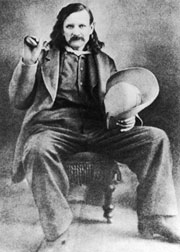 Jack Swilling, one of the founders of Phoenix.
Jack Swilling, one of the founders of Phoenix.
Hundreds of years before any of the cities in the eastern part of our country were so much as clearings in the wilderness, a well established, civilized community occupied the land we know as Phoenix. The Pueblo Grande ruins, which were occupied between 700 A.D. and 1400 A.D., testify to our city's ancient roots.
The wide Salt River ran through the Valley of the Sun, but there was little rain and no melting snow to moisten the brown earth from river to mountain range on either side.
Those former residents were industrious, enterprising and imaginative. They built an irrigation system, consisting mostly of some 135 miles of canals, and the land became fertile. The ultimate fate of this ancient society, however, is a mystery. The accepted belief is that it was destroyed by a prolonged drought. Roving Indians, observing the Pueblo Grande ruins and the vast canal system these people left behind, gave them the name "Ho Ho Kam" -- the people who have gone.
Phoenix's modern history begins in the second half of the 19th century. In 1867, Jack Swilling of Wickenburg stopped to rest his horse at the foot of the north slopes of the White Tank Mountains. He looked down and across the expansive Salt River Valley and his eyes caught the rich gleam of the brown, dry soil turned up by the horse's hooves. He saw farm land, predominately free of rocks, and in a place beyond the reach of heavy frost or snow. All it needed was water.
Returning to Wickenburg, he organized the Swilling Irrigation Canal Company, and moved into the Valley. The same year, the company began digging a canal to divert some of the water of the Salt River onto the lands of the Valley. By March 1868, water flowed through the canal, and a few members of the company raised meager crops that summer.
Phoenix Is Born
By 1868, a small colony had formed approximately four miles east of the present city. Swilling's Mill became the new name of the area. It was then changed to Helling Mill, after which it became Mill City, and years later, East Phoenix. Swilling, having been a confederate soldier, wanted to name the new settlement Stonewall after Stonewall Jackson. Others suggested the name Salina, but neither name suited the inhabitants. It was Darrell Duppa who suggested the name Phoenix, inasmuch as the new town would spring from the ruins of a former civilization. That is the accepted derivation of our name.
Phoenix officially was recognized on May 4, 1868, when the Yavapai County Board of Supervisors, the county of which we were then a part, formed an election precinct here.
A post office was established in Phoenix on June 15, 1868, with Jack Swilling as postmaster. The sharp whistle of the first steam mill in the Valley added a brisk note to the sound of emerging industry. It advertised the Richard Flour Mills, built in 1869, where the Luhrs Tower now stands.
Selecting a Townsite
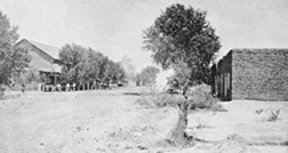 Washington Street in the 1870s.
Washington Street in the 1870s.
The rapid influx of pioneers continued, and by 1870, it was clear that a townsite had to be selected. On Oct. 20, 1870, a meeting was held to select such a site in the home of John Moore.
This well-known farmer offered 40 acres to the cause, but 320 were purchased by a popular subscription that raised $50. The official designation of this new townsite was the North Half of Section 8, Township 1 North, Range 3 East. Today, it would encompass the downtown business section, bounded on the north by Van Buren Street, on the south by Jackson Street, on the east by Seventh Street and on the west by Seventh Avenue.
To administer this new townsite, the Salt River Valley Town Association was formed with its articles carrying the following signatures:
Darrell Duppa
Wm. B. Hellings & Co.
Barnett and Block
Thomas Barnum
James Murphy
John T. Dennis
William A. Holmes
James M. Buck
Jacob Starar
John T. Alsap
Columbus H. Gray
Martin P. Griffin
James McC. Elliot
J. P. Perry
William Rowe
Michael Connell
Daniel Twomey
Charles C. McDermott
Edward Irvine
John P. Osborn
Andrew Starar
Paul Becker
James D. Monihon
John T. Alsap, James Murphy and J. P. Perry were selected by majority vote to be the townsite commissioners. Alsap acted as chairman and Capt. William A. Hancock was secretary.
Capt. Hancock was also a surveyor, and he made the first survey of the townsite and laid out the lots and the town. This first town of Phoenix was one mile long, a half-mile wide and contained 96 blocks. Washington Street was the main street and, on the early maps, showed to be 100 feet wide.
The east and west streets were named after our presidents. Washington Street was placed in the middle and Adams, who was the second president, was given the first street to the north. Our third president, Jefferson, had the first street south of Washington named after him. And the pattern followed - one to the north and one to the south - until recent years.
The north-south streets originally carried Indian names, but these were changed in favor of the more easily remembered numbers - with streets being to the east of Central Avenue and avenues to the west.
The Great Sale
The Prescott Miner carried the following advertisement on Dec. 7, 1870:
"GREAT SALE OF LOTS AT
PHOENIX, ARIZONA
on the 23rd and 24th of December."
The first effort resulted in the sale of 61 lots at an average price of $48 each. The first lot was purchased by Judge William Berry of Prescott. It was the southwest corner of First and Washington streets, and he paid the rather steep price of $116.
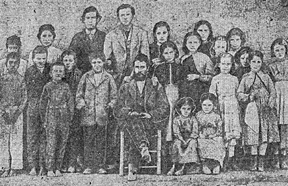 Phoenix's first school teacher, Jean Rudolph Darroche, surrounded by members of his 1871 class.
Phoenix's first school teacher, Jean Rudolph Darroche, surrounded by members of his 1871 class.
The first store building to be erected in the new town was Hancock's Store, a general store opened in July 1871, by William Smith. The adobe structure was built on the northwest corner of First and Washington streets and served as the town hall, county offices and general meeting place of early Phoenix.
Although various religious organizations had been formed by 1870, the first church building erected in Phoenix was the Central Methodist Church. It was built in 1871 at the corner of Second Avenue and Washington Street.
The first Catholic priest came to Phoenix in 1872. But it was not until after 1881 that an adobe church building, the Sacred Heart of St. Louis at Third and Monroe streets, replaced the Otero home as a place for Catholics to worship.
Yavapai County was divided on Feb. 12, 1871, when Maricopa County was created by the Legislature. The sixth county in the state, Maricopa, gave up portions in 1875 and 1881 to help form Pinal and Gila counties, respectively.
The first county election was held in 1871, when Tom Barnum was elected the first sheriff of Maricopa County. As a matter of historical interest, a shooting between two other candidates for the office, J. A. Chenowth and Jim Favorite, resulted in Favorite's death and Chenowth's withdrawal from the race.
Schooling for Phoenix's youth began in 1871. About 20 children studied under the guidance of Jean Rudolph Darroche in the courtroom of the county building. By October 1873, a small adobe school building was completed on Center Street (now Central Avenue), a short distance north of where the San Carlos Hotel now stands. Miss Nellie Shaver, a newcomer from Wisconsin, was appointed as the first female schoolteacher in Phoenix.
Whole Town Worth $550
On April 10, 1874, President Grant issued a patent to Judge Alsap for the present site of Phoenix. The declaratory statement was filed at the Prescott Land Office on Feb. 15, 1872. Official entry was made at the Florence Land Office on Nov. 19, 1873. The total cost of the Phoenix Townsite of 320 acres was $550, including all expenses for services.
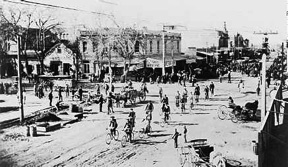 Cyclists adding to to the heavy traffic at Washington and First streets in the late 1880s.
Cyclists adding to to the heavy traffic at Washington and First streets in the late 1880s.
In 1874, downtown lots were selling for $7 to $11 each. That year also marked the entry into Phoenix of the first telegraph line. Morris Goldwater was the first operator of this station, located in his father's store on the northwest corner of First and Jefferson streets.
By 1875, there were 16 saloons, four dance halls, two monte banks and one faro table in Phoenix. The townsite-commissioner form of government, however, was not working well. At a mass meeting held at the courthouse on Oct. 20, 1875, an election was held to select three village trustees and other officials.
John Smith became the chairman of the trustees and Charles W. Stearns the treasurer, with Capt. Hancock continuing as secretary.
A safe location was required for the money being made in the Valley. To solve the problem, the National Bank was established in 1878 with capital stock of $200,000.
The first newspaper in Phoenix, the Salt River Valley Herald, changed its name to the Phoenix Herald in 1880. By this time, the paper had progressed from a weekly publication to semiweekly.
In 1880 Phoenix had a population of 2,453, a school enrollment of 379 pupils, an ice factory and a new brick sidewalk in front of the Tiger Saloon. On Nov. 26 of that same year, Maricopa County had its first legal hanging.
Incorporation in 1881
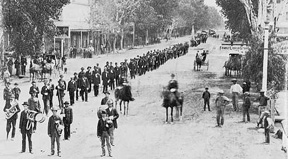 Parades were common in downtown Phoenix in 1884.
Parades were common in downtown Phoenix in 1884.
Just as Phoenix had outgrown its original townsite-commissioner form of government, it grew too large for the village trustee operation. "The Phoenix Charter Bill" was passed by the 11th Territorial Legislature. The bill made Phoenix an incorporated city and provided for a government consisting of a mayor and four council members. It was signed by Governor John C. Fremont on Feb. 25, 1881.
On May 3, 1881, the first election was held in the newly incorporated city with a population of approximately 2,500. The outcome:
MAYOR
John T. Alsap................................... 127 votes
James D. Monihon.......................... 102 votes
COUNCIL
T.W. Brown...................................... 198 votes
John H. Burger................................ 144 votes
W.T. Smith....................................... 120 votes
James M. Cotton............................ 107 votes
Mark Richardson............................ 104 votes
J.W. Clark........................................ 98 votes
Dr. Sheets........................................ 91 votes
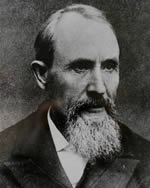 John T. Alsap Phoenix's first Mayor
John T. Alsap Phoenix's first Mayor
TREASURER
M.W. Kales...................................... 224 votes
MARSHAL
Henry Garfias.................................. 97 votes
James K. Burnett............................ 79 votes
Thomas Childs................................ 53 votes
The first regular meeting of the City Council was held on May 9, 1881. The first ordinance adopted was the one relating to the official seal of the city described as follows:
"In the center a bird rising, and surrounding this the inscription Phoenix, Arizona - Incorporated February 25, 1881."
The 11th Legislature attempted to have the United States Government establish a mint in Phoenix. The effort wasn't successful, but another enterprise saw its beginning. Holsum Bakery realized the opportunities Phoenix had to offer and opened its doors in 1881.
Within the next 10 years, great strides were made toward maturity of a modern city. In 1886, one of the first electric plants in the west was installed in Phoenix. It was a steam plant with boilers fired by mesquite wood.
That same year, the Phoenix Fire Engine Company Number 1 was organized. It was comprised of a volunteer group that served the city for many years.
Transportation: Horses and Rails
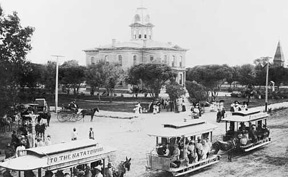 Horse-drawn streetcars pass by the old courthouse in the late 1890's.
Horse-drawn streetcars pass by the old courthouse in the late 1890's.
The first horse-drawn streetcar line was built along some 2 miles of Washington Street in 1887, and the kick off of this new mode of transportation was on Nov. 5. An additional line was installed along Center Street. The first car moved over those shaky rails on Dec. 30, 1889. The streetcar system became extensive in later years, with tracks covering most of Phoenix and extending to Glendale.
July 4, 1887, would have been just another Independence Day had not the first Southern Pacific train arrived that day from Maricopa Wells. This had been a long-anticipated event.
The coming of the railroad was the first of several important events that revolutionized the economy of this area. Merchandise now flowed into the city by rail instead of wagon. Our products went quickly to eastern and western markets. In recognition of the increased tempo of economic life, the Phoenix Chamber of Commerce was organized on Nov. 4, 1888.
That same year, the city offices were moved into the new City Hall, built where the downtown bus terminal now stands. This building also provided temporary offices for the territorial government when they were moved to Phoenix from Prescott in 1889.
The location of Arizona's Capitol had been moved several times since 1864. It was first established at Navajo Springs, then Prescott, then Tucson after an attempt to move it to La Paz failed, then back to Prescott, and finally to Phoenix.
The Bustling 1890s
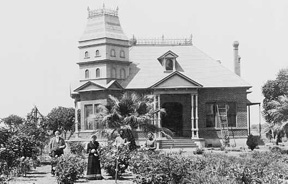 The Columbus and Adeline Gray mansion on Seventh and Mohave streets was a Phoenix showplace in the 1890s.
The Columbus and Adeline Gray mansion on Seventh and Mohave streets was a Phoenix showplace in the 1890s.
Twenty years had passed since Phoenix, like its legendary namesake, had risen from the ashes of a bygone community. The 1890s showed further indications of the heights to which this city would some day soar. The Arizona Republic became a daily paper in 1890, with Ed Gill as its editor.
In those days, none of the great reservoirs north of the Valley had been created to control the flow of water to the Valley. The year 1891 was marked by the greatest flood in the Valley's history, as well as by the advent of the first telephone system in Phoenix.
The horse-drawn streetcars were replaced in 1893 by electric cars. The electric cars stayed on the streets until the automobile replaced them on Feb. 17, 1948.
On March 12, 1895, the Santa Fe, Prescott and Phoenix Railroad ran its first train to Phoenix. It connected Phoenix with the northern part of Arizona and gave travelers another outlet to the east and west via the Santa Fe.
The additional railroad speeded the capitol city's rise to economic supremacy in the state. That same year, 1895, the Phoenix Union High School was established, and 90 young people were enrolled.
In 1897, an organization of 14 women called the Friday Club, started the public library movement in Phoenix. Their efforts led to formation of the Phoenix Library Association in 1899. The members subscribed at an annual rate of $3 for the maintenance of the small library housed in two upstairs rooms in the Fleming Building at First Avenue and Washington Street. The Phoenix City Council, however, levied a 5-mill tax for its public library a few months after the 1901 Legislature passed a bill allowing a tax to be applied to the support of free libraries. This action satisfied the conditions set by Mr. Andrew Carnegie in his proposal to donate a library building to the city. The Carnegie Free Library was opened on Feb.18, 1908.
By the turn of the century, the population of Phoenix had reached 5,554. More social outlets were being promoted, such as the Phoenix Country Club and the Women's Club, which were organized in 1900.
The state Capitol finally got a permanent home when a 10-acre lot was donated at the west end of Washington Street. A building was erected at a cost of $130,000. Gov. Murphy dedicated this building on Feb. 25, 1901. The newspaper reports of this event were set in type by members of the first labor union in Arizona, The Phoenix Typographical Union 352, which came into existence on Feb. 14, 1901.
Roosevelt and Reclamation
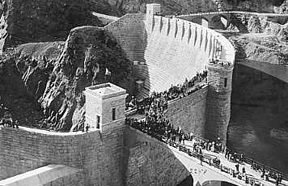 Roosevelt Dam opening ceremonies in 1911.
Roosevelt Dam opening ceremonies in 1911.
In 1902, President Theodore Roosevelt signed the National Reclamation Act making it possible to build dams on western streams for reclamation purposes, an important event for the people of Phoenix and the Valley.
Valley residents were quick to supplement this federal action by organizing the Salt River Valley Waters Users' Association on February 4, 1903, to assure proper management of the precious water supply. This organization still functions as the major agency for controlled use of irrigation water in the Valley.
Theodore Roosevelt Dam was started in 1906. It was the first multiple-purpose dam, supplying both water and electric power, to be constructed under the National Reclamation Act. On May 18, 1911, the former President himself dedicated the dam, which was the largest masonry dam in the world. This opened a new era in farming for the Valley and secured the part of our economy that depended on water for its life.
President William Howard Taft approved Arizona's statehood on Feb. 14, 1912. On March 18 of the same year, Gov. George Hunt called the first State Legislature into session.
Establishing a Council-Manager Government
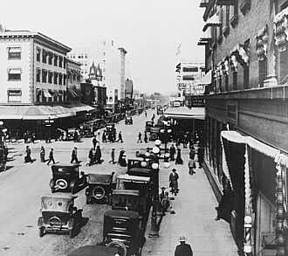 Looking north up Central Avenue and Washington Street in the 1920's.
Looking north up Central Avenue and Washington Street in the 1920's.
This was an auspicious step in the state's history, and in the following year, the City of Phoenix took an equally important one. At a special election on October 11, 1913, the people of Phoenix, by a vote of nearly two to one, ratified a new charter. The charter gave Phoenix the council-manager form of government. Thus, Phoenix became one of the first cities in the nation to adopt this progressive form of government.
Phoenix has the type of charter which gives home rule to a city, but it is not home rule in the complete sense of the word. Courts have ruled that if the Legislature passes a law which concerns cities and towns, the court determines if the law is of state-wide interest or of municipal or local concern. If the law is of state-wide interest, it is binding on the City of Phoenix, even though it contravenes some provision of the charter.
Therefore, the government of the City of Phoenix is operated by authority of the powers granted by its charter, as limited by the Legislature. This is in contrast to the operation of the government of cities and towns that do not have charters but operate by the general statutes of the state relating to cities and towns.
An election, as provided for in the new charter, was held on March 19, 1914, with the following results:
MAYOR
George U. Young........................ 2336 votes
Ernest W. Lewis.......................... 1835 votes
COMMISSIONERS
Joseph Cope.............................. 2618 votes
Peter Corpstein.......................... 2131 votes
Michael J. Foley.......................... 1950 votes
Frank Woods.............................. 1933 votes
Victor R. Norris........................... 1873 votes
George Norman McBean.......... 1744 votes
L. D. Dameron............................ 1617 votes
Harry A. Diehl.............................. 1461 votes
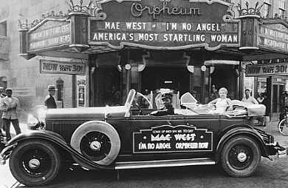 Mae West came to town in 1929 to impress upon the locals that she wasn't play-acting in "I'm no Angel."
Mae West came to town in 1929 to impress upon the locals that she wasn't play-acting in "I'm no Angel."
In the presence of Thomas J. Prescott, on April 17, 1914, the new Mayor and the winning four commissioners took their oaths of office. Thus began a third form of government for Phoenix. The late William Addison Farish, a widely known civil engineer, was selected as the first city manager. City officials appointed by Farish, according to the provisions of the new charter, were the following:
C.M. Cooper.......................... Auditor
George D. Christy................. Attorney
J. C. C.H. Boone................... Treasurer
John McBride........................ Magistrate
George Brisbois................... Chief of Police
Growing into a Metropolis
With the advent of statehood, Phoenix, as well as Arizona, had come of age. The casual, easy growth that characterized a farming community slowly came to a stop. Phoenix began to grow into a young metropolis. At the end of its first eight years under statehood, Phoenix was no longer a town - it was an important city of 29,053.
Two thousand youngsters were attending Phoenix Union High School in 1920. They would throw each other into Jack Swilling's first canal, which ran through the campus and had become the "Town Ditch." A total of 1,080 buildings went up that year. Among them was Arizona's first skyscraper, the Heard Building.
In those eight years, Phoenix also developed the makings of its first political scandal - the $1,300,000 bond issue of 1919 to build a redwood pipeline from the Verde River to Phoenix. The pipeline was finished in 1920, but never worked too well. Today, the portion of that redwood that isn't still underground serves to form walls for the houses of the Indians living near Fort McDowell.
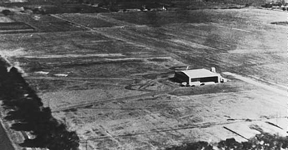 Sky Harbor Airport was just getting started in 1934.
Sky Harbor Airport was just getting started in 1934.
By 1930, the size of Phoenix nearly doubled again with a 48,118 census count. There were 120 miles of sidewalks and 161 miles of streets - 77 with pavement. The public library had 51,000 books, and the police force had 70 men. The budget for the city came to $2,033,886. Another pipeline was built - this time constructed with 48 inches of concrete, which still carries Verde River water to us.
The year 1940 marked another turning point in Phoenix life. The city had gone as far as a farming center and then as a distribution center. When the war hit the United States, Phoenix rapidly turned into an embryonic industrial city. Luke Field, Williams Field and Falcon Field, coupled with the giant ground training center at Hyder, west of Phoenix, brought thousands of men into Phoenix. Their needs, both military and personal, were met in part by small industries in Phoenix.
When the war ended, many of these men returned to Phoenix, and families came with them. Suddenly thousands of people were wondering what to do for a living. Large industry, learning of this labor pool, started to move branches here. Smaller plants were started by private capital and initiative. Water again began to run out as it had done several times before, but citizens were more fortunate than the Ho Ho Kam who built the first canals and saw them go dry. Phoenix had the greatness of American technology to fall back on. The era commencing with 1940 marked the end of agriculture's role as our chief provider. It was the beginning of a greater prosperity than Phoenix had ever known.
In 1950, 105,000 people lived within the city limits of Phoenix and thousands more lived immediately adjacent to and depended upon Phoenix for their livelihoods. The city had 148 miles of paved streets and 163 miles of unpaved streets, a total of 311miles of streets within the city limits.
Governmental Reform
The men who, in 1914, changed the governmental system to the council-manager form, had hoped that this would provide better city government. Their hopes had not been fulfilled, however. A long succession of managers, nearly one-a-year, had indicated that the Council placed political favor above the job of efficiently running a city.
In November 1948, the people voted to strengthen the city manager's position in municipal government. This change, plus raising the Council membership to seven, seemed to place the city in position to go ahead with an operable council-manager form of government. But that didn't happen. The Council then in power selected its own manager and continued to rule the administrative roost.
In 1949, the people, tired of this continued abuse, elected an entirely new slate of Council members, including the first female Council member, Margaret Kober (Mrs. Leslie R. Kober).
The results of these governmental reforms have been spectacularly demonstrated. The same city manager selected by that first Council remained in office more than 11 years, despite the fact that he served under five different mayors and 27 different Council members. This provided a continuity in management that proved invaluable, considering the tremendous growth of the city. Despite predictions that he wouldn't last six months, City Manager Ray Wilson remained at his desk until his voluntary retirement in early 1961, after breaking every record ever established by previous managers.
A Major American City
Perhaps the development of Phoenix since 1950 has been the most spectacular of all. Consider that at that time, Phoenix had an area of 17.1 square miles and a population of 106,000 that placed it 99th among American cities.
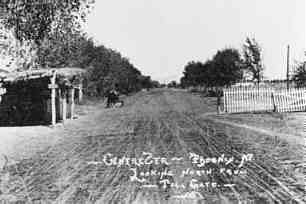 A toll gate at Central and McDowell avenues in the 1880s was owned by the Central Avenue Improvement Association, a subsidiary of the Arizona Water Co. The toll for wagons and buggies was 25 cents. Bicycles were free, and the town was full of bicycles.
A toll gate at Central and McDowell avenues in the 1880s was owned by the Central Avenue Improvement Association, a subsidiary of the Arizona Water Co. The toll for wagons and buggies was 25 cents. Bicycles were free, and the town was full of bicycles.
Today, the city covers more than 500 square miles and has a population of more than 1.4 million, ranking it sixth in the country. While Phoenix is the corporate and industrial center of the southwest it has not forgotten its past. It has retained its long-time reputation of friendliness and concern of its citizens for one another and their government.
This has been attested to by the National Civic League, which four times since 1950 selected Phoenix as an "All-America City" in competition with hundreds of other cities and towns across the nation.
The hallmark of an All-America City is the extent that its private citizens get involved in the workings of their government. Thousands of citizens have served on various city committees, boards and commissions to assure that major decisions are in the people's best interest.
Since 1950, the residents of Phoenix have shown their faith in city government by approving bond issues totaling about $3.5 billion for necessary improvements in urban facilities and services. The 1988 Phoenix bond election, which authorized the issuance of more than $1 billion in bonds, is one of the largest general-purpose municipal bond elections ever.
Among the projects funded by the bonds were:
- Establishment of the Phoenix Mountains Preserve Program, a 6,000 acre open-spaces project, unprecedented in urban America.
- Expansion of the Civic Plaza, which was increased in size to 340,000 square feet in 1985 and renovated in 1995 so that it now can accommodate some of the country's largest conventions and conferences.
- Development of Phoenix Sky Harbor International Airport, which serves almost 25 million commercial passengers a year and is among the fastest growing airports in the country. The latest addition to the facility came in 1990 with the opening of the Barry Goldwater Terminal 4.
- Building of the 20-story Phoenix City Hall, which opened in 1993 and now houses about 1,300 city employees.
- Opening of the Central Library in 1995.
- Construction of the History Museum and Arizona Science Center in 1996.
- Expansion of the Phoenix Art Museum in 1996.
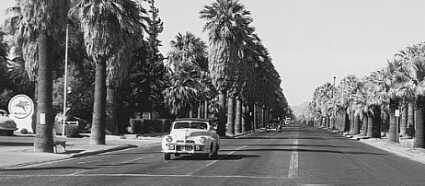 Central Avenue in 1948.
Central Avenue in 1948.
Currently, more than $1 billion in public and private projects are under construction or planned in the city. The City Council guides this unprecedented growth with an approach designed to preserve and enhance the lifestyle that originally attracted so many people to Phoenix.
The work of the council, the city staff and the many citizen volunteers has earned Phoenix much recognition over the years, both nationally and internationally.
In addition to its four All-America City titles, Phoenix won the 1993 Carl Bertelsmann Prize, a prestigious international competition that recognized the best-run city government in the world. Phoenix, which shared the prize with Christchurch, New Zealand, was praised for its highly efficient and customer-oriented programs.
Also:
- Financial World magazine named Phoenix the best managed among the nation's largest cities in 1995 and 1991, and City and State magazine honored Phoenix with the title of Most Financially Sound Large City in 1991.
- The Phoenix Sister Cities Commission received the Best Overall Program award from the Reader's Digest Association in 1995.
- Sky Harbor International Airport won the Airport Council International's North America Peggy G. Hereford Airport Communications Excellence Award in 1994.
- City Manager Frank Fairbanks was named 1994 Municipal Leader of the Year by the American City and County Magazine.
- Phoenix won top national honors in 1994 from the National Association of Town Watch for its National Night Out activities.
- Phoenix received the distinguished Public Enterprise Award in 1991, the highest honor bestowed upon a city, in the annual Technology Achievement Awards competition sponsored by Public Technology Inc.
- Phoenix was the only city in the country selected to represent "Excellence in the Public Sector," a national PBS television special produced by management expert Tom Peters.
- In 1989, Business Month Magazine named Phoenix one of the nation's 10 best-managed cities.
- Sky Harbor Airport was selected the nation's best airport for passenger amenities by Money Magazine in 1988.
- The Phoenix Personnel and Parks, Recreation and Library departments each earned the highest awards by their professional organizations (Agency Award for Excellence, International Personnel Management Association, 1988; and Gold Medal Award, National Parks and Recreation Association, 1968 and 1986).
Visit our Awards webpage to learn about more city recognition.
Blessed with energetic and interested citizens willing to give of their time to solve tremendous problems of growth, Phoenix faces an era of unlimited development. As long as the people have vision, the past will be but a prologue of what is to come.
Credits
James M. Barney, Arizona historian and Barry M. Goldwater, former Phoenix City Councilman and U.S. Senator, prepared the history for the 1951 Phoenix City Code. It was brought up to date for the 1962 Code by Jack Williams, former City Councilman, Mayor and Governor.
Photographs from SRP, Bob Rink and the collection of Herb and Dorothy McLaughlin. Also, from Department of Archives and Manuscripts, University Libraries, the Phoenix Elementary School District, Arizona State University (all others).
